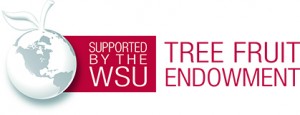Authors: Robert Orpet and Molly Sayles; WSU Entomology. March 9, 2023
The Pear Insects Lab at WSU-TFREC is monitoring pear pests at seven commercial locations in the Wenatchee Valley in addition to the WSU research center orchard (‘Sunrise’) near Rock Island (Figure 1). At each location, one block follows our phenology-based IPM guidelines and another block follows standard conventional management. We are also monitoring organically managed blocks at three of the locations. All blocks contain mostly Anjou and Bartlett trees planted >50 years ago, except for Rock Island, which was planted in 2007.
A weekly update in our pear pest, natural enemy, and pear psylla degree-day model information is publicly posted weekly in Pear Entomology Weekly.
Pear Entomology Weekly (PEW)
Most current issue: Vol. 1, Issue 14, June 23
New issues come out Fridays. To receive weekly to your e-mail on time, you can subscribe with our web form.
Spring milestone issue: Vol. 1, Issue 9, May 18
This issue summarizes the Spring 2023. The following issues switch to different methods for sampling summer pear psylla and start with new graphs.
How we Sample
We sample pear psylla adults and natural enemies with beat tray taps. In spring, we collect buds to monitor psylla eggs and nymphs. In summer through fall, we collect leaves to monitor psylla eggs and nymphs, mites, and earwigs.
Dr. Robert Orpet
Postdoctoral Research Associate
WSU Tree Fruit Research & Extension Center
1100 N Western Ave., Wenatchee, WA 98801
robert.orpet@wsu.edu
Molly Sayles
PhD student
WSU Tree Fruit Research & Extension Center
1100 N Western Ave., Wenatchee, WA 98801
molly.sayles@wsu.edu
Use pesticides with care. Apply them only to plants, animals, or sites listed on the labels. When mixing and applying pesticides, follow all label precautions to protect yourself and others around you. It is a violation of the law to disregard label directions. If pesticides are spilled on skin or clothing, remove clothing and wash skin thoroughly. Store pesticides in their original containers and keep them out of the reach of children, pets, and livestock.
YOU ARE REQUIRED BY LAW TO FOLLOW THE LABEL. It is a legal document. Always read the label before using any pesticide. You, the grower, are responsible for safe pesticide use. Trade (brand) names are provided for your reference only. No discrimination is intended, and other pesticides with the same active ingredient may be suitable. No endorsement is implied.





